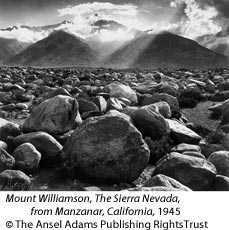|
ANSEL ADAMS: Classic Images
Mount Williamson, The Sierra Nevada, from Manzanar,
California, 1945
To learn more about this photograph see the information below. To see a larger view of this image as a PDF file format, click on the image... This image is copyrighted by The Ansel Adams Publishing
Rights Trust and cannot be printed or reproduced in any way. The
use of the photograph is limited to viewing in the context of this
web site.
|
|
|
Mount Williamson, The Sierra Nevada, from Manzanar,
California, 1945 A. Did you know that during World War II, the American
government set up a detention center for Japanese Americans? A. Did you know that during World War II, the American government
set up a detention center for Japanese Americans? B. Do you think nature has the power to inspire the imprisoned? C. What time of day and weather conditions did Adams prefer? "It is difficult to photograph on the ordinary bright, clear desert
days, as the value of the rock may blend with that of the sky. But in
days of storm it is magnificent, especially under the thunderstorms
of summer…The huge clouds and curtains of rain over the summits
are spectacular." D. Do you think Adams merely recorded the scene with a mechanical
device (the camera)? If not, what artistic decisions did he make? "Several times I moved the car a few feet to position the camera
precisely for the composition of boulders and peaks." A problem
with photographing mountains, is that "the granite and metamorphic
rock blends gently with the near-horizon sky". Such conditions
are "usually disappointing in black-and-white, and "cry for
near-far composition of significant foreground, with the mountains relegated
to non-dominant proportions in the image." He said he made several
negatives of this scene. "In all but one the cloud positions and
the lighting on the mountains were not satisfactory and the negatives
were discarded." E. Technical Aspects
F. Related links in this site
|
|
|
ANSEL ADAMS: Classic Images
Mount Williamson, The Sierra Nevada, from Manzanar,
California, 1945
To learn more about this photograph see the information below. To see a larger view of this image as a PDF file format, click on the image... This image is copyrighted by The Ansel Adams Publishing
Rights Trust and cannot be printed or reproduced in any way. The
use of the photograph is limited to viewing in the context of this
web site.
|
|
|
Mount Williamson, The Sierra Nevada, from Manzanar,
California, 1945 A. Did you know that during World War II, the American
government set up a detention center for Japanese Americans? A. Did you know that during World War II, the American government
set up a detention center for Japanese Americans? B. Do you think nature has the power to inspire the imprisoned? C. What time of day and weather conditions did Adams prefer? "It is difficult to photograph on the ordinary bright, clear desert
days, as the value of the rock may blend with that of the sky. But in
days of storm it is magnificent, especially under the thunderstorms
of summer…The huge clouds and curtains of rain over the summits
are spectacular." D. Do you think Adams merely recorded the scene with a mechanical
device (the camera)? If not, what artistic decisions did he make? "Several times I moved the car a few feet to position the camera
precisely for the composition of boulders and peaks." A problem
with photographing mountains, is that "the granite and metamorphic
rock blends gently with the near-horizon sky". Such conditions
are "usually disappointing in black-and-white, and "cry for
near-far composition of significant foreground, with the mountains relegated
to non-dominant proportions in the image." He said he made several
negatives of this scene. "In all but one the cloud positions and
the lighting on the mountains were not satisfactory and the negatives
were discarded." E. Technical Aspects
F. Related links in this site
|
|
